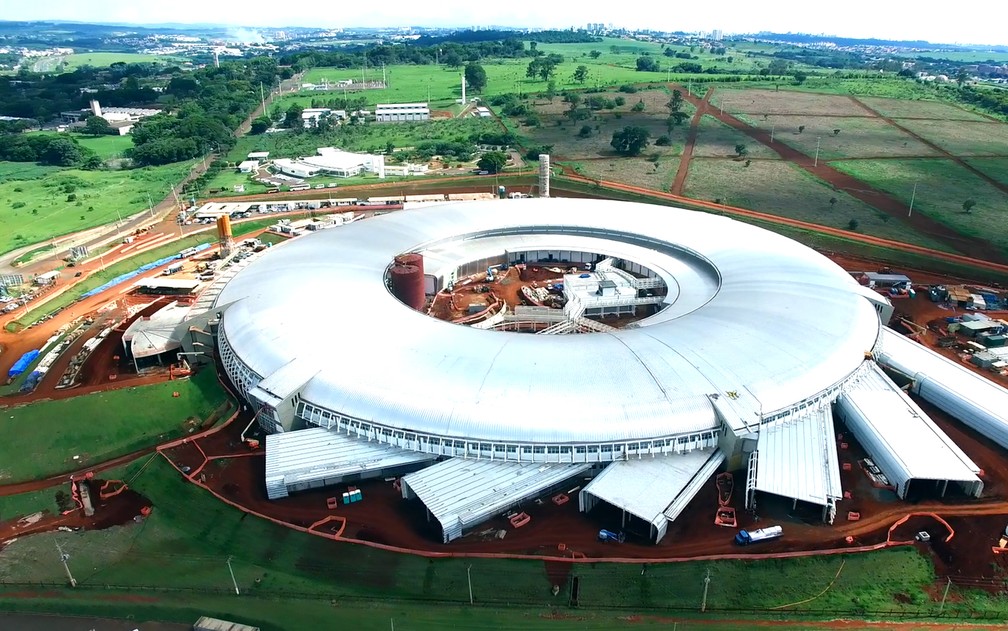14 November 2018 is a day to be remembered by the global scientific community. In the hilly landscape of Campinas – a region in Brazil’s southeastern inland once dominated by wooden sugar mills and slave run coffee plantations – one of the most advanced scientific infrastructures in the world has been unveiled. “Sirius”, fittingly named after the brightest star in the night sky, is a 4th generation synchrotron light source and is poised to host groundbreaking research in various areas of knowledge. With its high brightness beams it is capable of revealing inner characteristics of materials no other scientific apparatus has ever been able to. Not only to the benefit of Brazilians, but to the whole world.
Sirius started of as an anxious dream. Back in 2003 - barely 6 years after Brazil had inaugurated its first synchrotronradiation source, UVX – discussions on the need of a more developed facility initiated within the Brazilian Center for Research in Energy and Materials (CNPEM). Five years later, the draft project proposal was presented to the Ministry of Science, Technology and Innovation and in 2010 its initial design was shared with the global community at the 1stInternational Particle Accelerator Conference (IPAC10) in Kyoto, Japan. It was not until 2013 that the earthwork on the recently acquired terrain (a land of 150,000 sqm right beside CNPEM’s headquarters) began, followed soon after by construction. Last November, the first phase of Sirius was officially opened. The complete facility should be operational by 2020.
In simple terms, Sirius is a gigantic X-ray capable of revealing the inner details of both organic and inorganic matter. Simplicity is, however, not an attribute to be associated with this round giant, as it is one of the most complex and technologicallyequipped scientific infrastructures to be built on our planet. It uses a two-set particle accelerator to inject and then boost electrons almost to the speed of light. A nearly 500 metres long circular storage ring then keeps the electron beams for hours while they are producing synchrotron light.Experimental stations – called “beamlines” - located around the ring allow researchers to control the receiving radiation and thus analyse molecular and atomic properties of specific materials.
According to the plan defined by CNPEM, Sirius will house 13 beamlines. Each one varies in size and layout, and therefore serves specific observation techniques: x-ray nanoscopy, powder diffraction, x-ray spectroscopy, high-energy tomography, x-ray scattering, infrared microspectroscopy, nanocryst allography, among others. Thanks to the brightness (i.e. number of photons emitted) of the synchrotron light produced by Sirius, the beamlineswill enable researchers to map materials with micro and nano meter accuracy and to make three-dimensional images with improved contrast and temporal resolution.
The Max IV laboratory in the Swedish city of Lund is the only other light source that matches Sirius’ capabilities. Both carry important advancements of technology and design that generate high energetic electron beams along with ultra low emittance levels (i.e. divergence), thereby achieving an unparalleled degree of brightness. They are the latest frontier of a journey that started back in 1944 when Iwanenko and Pomeranchuk predicted synchrotron radiation and in 1947 when it was observed for the first time in General Electric’s R&D labs. The Indus 2, built and operated under the auspices of the Raja Ramanna Centre for Advanced Technology in Indore, Madhya Pradesh, is an important part of this very same history.
The benefits Sirius will bring to society are unlimited, to say the least. In agriculture, it will enhance analysis of soil compounds, usually a complex mixture of organic and inorganic elements embedded in wet solutions. A better understanding of the atomic structure and processes of rural grounds may lead to practices that improve productivity and avoid the excessive use of chemicals. Likewise, the powerful photonic beams will provide biologists with more accurate mappings of nutrients in plants as well as of contamination and diseases.
On the energy domain, the increased research potential may lead to real revolutions related both to traditional and renewable sources. According to CNPEM, Sirius will “facilitate the understanding of the mechanical and transport properties of heterogeneous materials, such as those that typically hold oil and natural gas. It will also allow studies on various conditions of temperature and pressure, useful for the development of the exploration in deep waters”[1]. Similarly, by enhancing the observation of interactions between photons and electrons, and of atomic and molecular bonds, it can significantly improve research and development on solar energy, fuel cells and storage systems such as batteries.
Health and medicine will also significantly benefit from analysis conducted in Sirius’ beamlines. Three-dimensional figures of proteins which influence cellular processes are essential to the development of new drugs and treatments against inflammatory diseases and diabetes, for example. Furthermore, the increasedresolution of the tomography of cells and improved contrast of images of organs and tissues may support progress in the study of cancer.
Brazilian society and industry are not the only ones to take advantage from the new research facilities. Sirius is being built mainly (85%) with Brazilian technology, but is likely to benefit R&D around the world. Since the first plans, it has been conceived as an infrastructure with an international remit. Throughout the conceptual and construction phases, a committee of international synchrotron light experts from Europe, Asia and North America has routinely visited Campinas in order to assess and comment the progress of the project. Last March, CNPEM hosted the 2nd meeting of the BRICS Working Group on Research Infrastructure and Sirius was presented as one of the Brazilian facilities that could possibly be used by scientists from the other countries of the block, including India.
Sirius, the shining star that for thousands of years has been guiding women and men in theircontinuous struggle for subsistence, now lends its name to one of mankind’s greatest technological achievements. The bright light that is about to radiate around the clock in Campinas is likely to aid humanity further in its steps into the future.
